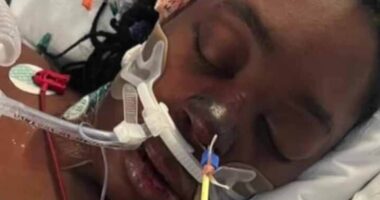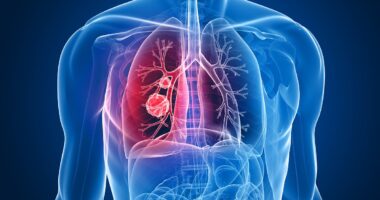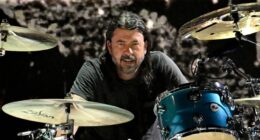
A 29-year-old from Ohio with a rare medical condition that left her in so much pain she was unable to eat had to travel 4,000 miles in order to receive life-saving surgery in Germany.
Kristina Bayus-Roszak, a marketing specialist, first noticed something was wrong with her health after she lost 30lbs in just six weeks because she was in excruciating pain that made it nearly impossible for her to eat.
She was suffering constant nausea and vomiting and severe abdominal pain.
Doctors were finally able to diagnose her with Dunbar syndrome, a rare disease affecting just two in 100,000 people in the US.
The disease, also known as median arcuate ligament syndrome, is a condition in which the arc-shaped band of tissue in the chest area – the median arcuate ligament – presses on the celiac artery, which sends blood to the upper abdomen.
In Ms Bayus-Roszak’s case, her artery was compressed in multiple places, leading to more severe symptoms and pain.
Following her diagnosis, she was given less than two years to live if she did not undergo lifesaving surgery to repair the celiac artery, a surgery, she said, no US doctor would perform.
Ms Bayus-Roszak said: ‘Mine was one of the worst cases they’d ever seen. My body was shutting down. I was slowly starving to death.’
Desperate and lacking options, she flew to Leipzig, Germany, to be examined by a highly specialized physician.
Once there, she was given an advanced ultrasound scan and diagnosed with five more extremely rare disorders, which are all characterized by similar abdominal vascular compressions.
She was then sent to Dusseldorf for an eight-hour surgery, during which the band of tissue compressing the artery was cut, relieving pressure and restoring blood flow to the abdomen.
Her surgeon also found an abdominal aneurysm – an enlargement of the abdominal portion of the aorta, the largest artery in the body – that would have ruptured within a month had it not been found.
She said: ‘My husband Kyle made the journey with me and I could not have done it without him.
‘My friends and family also did multiple fundraisers and a GoFundMe to help me get there. I wouldn’t be where I am today without their love and support.’
Two years after the procedure, Ms Bayus-Roszak’s life has improved immeasurably.
She said: ‘My surgeon is nothing short of extraordinary. I am doing so much better, and I have the ability to eat once more, which I’ll never take for granted again.’
She has also slowly gained her weight back, and her organ health has substantially improved.
‘I’m also no longer in chronic pain and can get back to doing the things I love, like hiking. I have my life back,’ she added.
Surgery, like that performed on Ms Bayus-Roszak, is the the only treatment for Dunbar syndrome.
Ms Bayus-Roszak added: ‘I am so proud of my ability to persevere through this. There was nothing easy about traveling to a foreign country for a major surgery. I wasn’t even sure if I’d survive.
‘I did survive though and while it was the hardest thing I’ve ever dealt with, I made it through and I am a stronger and a better person for it.
‘I wish people knew how incredibly strong those with vascular compressions and rare diseases are. Research and treatment options are limited, and half of the medical professionals don’t even understand.
‘My goal now is to bring awareness and help to so many others suffering from these debilitating and even deadly rare diseases.’
Rare diseases are notoriously difficult to treat due to limited available therapeutic options.
Because some diseases are so rare and affect a relatively small proportion of the population, pharmaceutical companies have little financial incentive to develop new treatments or cures, given that few people will actually buy them.
According to The Lancet Global Health, about 95 percent of rare diseases lack approved treatments.
Most rare diseases – 80 percent – are genetic and almost 70 percent appear in childhood.
There have been major breakthroughs in rare disease research, including genetic testing to diagnose rare neurological disorders and the passage of the Orphan Drug Act of 1983, which provides tax incentives for research into rare diseases and development of cures.
But the report’s authors said: ‘However, even when we do have treatments, there is no promise of accessibility for all.
‘For instance, Hemgenix, a gene therapy to treat hemophilia B based… costs up to $3.5million per case in the US.’
They added: ‘Insufficient awareness of their rare disease among health-care staff and communities can result in patients’ symptoms being invalidated, visible symptoms of the disease can result in social discrimination, and schools and employers can fail to address accessibility needs.’
Ms Bayus-Roszak said: ‘We fight every day for care even when we are dealing with the cruelest pain and symptoms. If you have someone in your life struggling with a chronic illness, rare or not, please give them some grace.
‘Remind them they are loved and they are worthy. Understanding and kindness go such a long way.’









